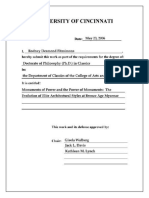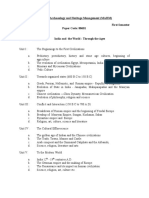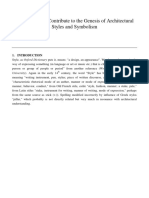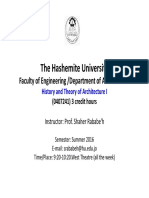HOA II Syllabus
HOA II Syllabus
Uploaded by
radhikaCopyright:
Available Formats
HOA II Syllabus
HOA II Syllabus
Uploaded by
radhikaOriginal Description:
Copyright
Available Formats
Share this document
Did you find this document useful?
Is this content inappropriate?
Copyright:
Available Formats
HOA II Syllabus
HOA II Syllabus
Uploaded by
radhikaCopyright:
Available Formats
Code Name Credits L S P T
CSA-1201 History Of Architecture & Human Settlements -II 3 3 3
Assessment Method
1 Internal Assessment 50%
2 End Semester Examination 50%
3 External Jury
Total 100%
Subject Objective: To provide an insight into the architecture of Classical antiquity & early
Medieval period. Social, religious, political and architectural character, construction methods,
building materials and settlement planning shall be explained with suitable examples. To
provide an understanding of the evolution of Classical architecture in the west in addition to
Indian Architecture in its various stylistic modes characterized by technology, ornamentation
and planning practices. Combined influence of geology, geography, climate, beliefs, religion and
culture on the architecture must be highlighted so as to appreciate how architecture is
embedded in place-specific context. The study must enable students to do a comparative
evaluation of developments in a chronological manner along the timeline and across different
geographies. Also, students must be enabled to appreciate tangible and intangible aspects of
heritage associated with history.
Unit-I. Classical Architecture - Greek Architecture and Roman Architecture
Study of Design Principles, Proportion, Optical corrections and Classical Orders. Building type’s
viz.,Temples, Sanctuaries, Thermae, Amphitheatres, Circus, Aqueducts and etc. Study of
planning principles adopted, Agora, Forum and their effect on settlement planning.
Unit-II. Early Christian Architecture
Study of Architectural character, evolution of Church form, building typologies, and building
elements, polymath architecture, Baptisteries, early Basilican churches; settlement planning,
and fortification systems.
Unit-III. Buddhist Architecture in India
Study of religious philosophy, resultant evolution of building typologies, building elements and
associated forms during Hinayana and Mahayana phases. Types of structures and elements
developed eg: Stupas, Viharas, Chaityas, Stambhas, Toranas, sacred railing etc. in India. Study
of form variations
across various countries.
Unit-IV. Indo Aryan Architecture
Development of fortification, walled towns, settlement patterns and the causative factors. Role
of Shilpasasthras and Arthashasthra in settlement planning. Study of worshipping places in Indo
Aryan / Nagara style, design of buttressed shikharas, rock-cut and structural examples of
temples.
Unit-V. Dravidian Architecture
Development of fortification, walled towns, settlement patterns and the causative factors. Role
of Shilpasasthras in settlement planning. Study of worshipping places in Dravidian style (Chola,
Chalukya, Pallava, Satavahana, Hoysala, Vijayanagara etc.), design of Gopuram and Shikhara,
Hindu, Buddhist and Jain cave and rock-cut temple architecture.
References:
Brown, P. (2010). Indian Architecture: Buddhist and Hindu period. Mumbai : D. B.
Taraporevala Sons and
Co.
Bubbar, D. K. (2005). The Spirit of Indian Architecture. New Delhi : Rupa & Co.
Copplestone, T. and Lloyd, S. (1971). World Architecture: An Illustrated History. London :
Verona Printed.
Crouch, P. D. (1985). History of Architecture: Stonehenge to Skyscrapers. London :McGraw-
Hill.
Costof, S. (2012). A History of Architecture: Settings and Rituals. New York : Oxford
University Press.
Dutt, B. B. (2009). Town Planning in Ancient India. Delhi : Isha Books.
Kimball, F. and Edgell, G. H. (2012). A History of Architecture. Amazon : Ulan Press.
Fletcher, B. (1996). A History of Architecture on the Comparative Method. 20th Ed. London :
B.T. Batsford
Ltd.
Grover, S. (2003). Buddhist and Hindu Architecture in India. 2nd Ed. New Delhi :CBS
Publishers.
Hamlin, T. F. 1953. Architecture through the Ages. New York : Putnam Adult.
Harris, M. C. (1977). Illustrated Dictionary of Historic Architecture. New York : M. Courier
Dover
Publications.
Ingersoll, R. and Kostof, S. (2013). World architecture: a cross-cultural history. Oxford : Oxford
University
Press.
Pramar, V. S. (2005). A social history of Indian architecture. New Delhi : Oxford University
Press India.
Roth, M. L. (2006). Understanding Architecture: Its Elements, History, and Meaning. Columbia
: West-view
Press.
Sengupta, B. K., Sen, J. and Banerji, H. (2010). Reading material on Human Settlements.
Institute of Town
Planners of India, New Delhi.
Singh, U. (2009). A history of ancient and early medieval India: from the Stone age to the 12th
C. Delhi :
Pearson India.
Watkin, D. (2005). A History of Western Architecture. 4th Ed. London :Laurence King
Publishing
You might also like
- Japanese Vernacular ArchitectureDocument86 pagesJapanese Vernacular Architecturefcharaf100% (3)
- 1 Prehistoric and Egyptian Architecture PDFDocument119 pages1 Prehistoric and Egyptian Architecture PDFInspirations & ArchitectureNo ratings yet
- Screenshot 2021-12-29 at 11.04.27Document40 pagesScreenshot 2021-12-29 at 11.04.27navidshabanzadeh100% (1)
- Reichian Psychology and The Concept of DOR (Dead Orgone)Document12 pagesReichian Psychology and The Concept of DOR (Dead Orgone)Ian Irvine (Hobson)No ratings yet
- O Level Past PaperDocument4 pagesO Level Past PaperDhanBahadur100% (2)
- Categorization of Symbolism in Religious ArchitectureDocument13 pagesCategorization of Symbolism in Religious Architectureρεζίν ντέιNo ratings yet
- Ar8301 History of Architecture and Culture IiDocument2 pagesAr8301 History of Architecture and Culture IiAyeesha ANo ratings yet
- 2011ar 101 Architectural Design I: ObjectivesDocument22 pages2011ar 101 Architectural Design I: Objectivesvishnu vijayanNo ratings yet
- BID 316 History of Interior Design Course OutlineDocument5 pagesBID 316 History of Interior Design Course OutlineZahid5391No ratings yet
- B. Arch. III Semester Syllabus 2017 RegulationDocument10 pagesB. Arch. III Semester Syllabus 2017 RegulationMoizu fathimaNo ratings yet
- SYLLUBUS B Arch MGUDocument108 pagesSYLLUBUS B Arch MGUShilaja M PNo ratings yet
- Culture ArchevensemDocument3 pagesCulture ArchevensemDEVIPRIYANo ratings yet
- 2022-23 History of Architecture I-ARCH 1104 Lec1Document66 pages2022-23 History of Architecture I-ARCH 1104 Lec1rh.rassan.connectNo ratings yet
- Cultural Influence On Architecture - SubmittedDocument27 pagesCultural Influence On Architecture - SubmittedNewton GacheruNo ratings yet
- RetrofittingDocument8 pagesRetrofittingGowriNo ratings yet
- Aspect of Art and Architecture PDFDocument8 pagesAspect of Art and Architecture PDFGee CeeNo ratings yet
- Architecture & Town Planning CE-208 (Introduction)Document21 pagesArchitecture & Town Planning CE-208 (Introduction)Sardar Muhammad Sami 285-FET/BSCE/F21No ratings yet
- IIT Kharagpur: Chapter I: IntroductionDocument11 pagesIIT Kharagpur: Chapter I: IntroductionShiny Deva PriyaNo ratings yet
- Architecture and Culture: Built Environment, Landscape and SocietyDocument2 pagesArchitecture and Culture: Built Environment, Landscape and SocietyMalavikaNo ratings yet
- The Influence of Culture On Architectural DesignDocument5 pagesThe Influence of Culture On Architectural DesignalduaijrayanNo ratings yet
- 2016 QB Daa 403Document13 pages2016 QB Daa 403Salman Qureshi100% (1)
- Art and Architecture FinalDocument8 pagesArt and Architecture FinalBarathNo ratings yet
- 2455 6545 1 PBDocument10 pages2455 6545 1 PBsalokhutdinovaNo ratings yet
- Monuments of Power and The Power of MonuDocument453 pagesMonuments of Power and The Power of Monuarheo111No ratings yet
- Mayan ArchitectureDocument76 pagesMayan ArchitectureMily Martinez OrellanaNo ratings yet
- Ancient Indian ArchitectureDocument86 pagesAncient Indian ArchitectureRishika100% (2)
- Master in Archaeology and Heritage Management (MAHM) First Semester Paper Code: 88601Document34 pagesMaster in Archaeology and Heritage Management (MAHM) First Semester Paper Code: 88601ArunBharadwajNo ratings yet
- History of Architecture-IDocument93 pagesHistory of Architecture-IolaNo ratings yet
- ITK ReportDocument13 pagesITK Reportrr0734No ratings yet
- Arly Islamic Architecture and Structural Configurations: AbstractDocument8 pagesArly Islamic Architecture and Structural Configurations: AbstractedrisNo ratings yet
- Theory of ArchitectureDocument53 pagesTheory of ArchitecturechaplinNo ratings yet
- UntitledDocument231 pagesUntitledNishan RaiNo ratings yet
- Jadavpur University V Year SyllabusDocument22 pagesJadavpur University V Year SyllabusMd Shahroz AlamNo ratings yet
- 9001 Lecture 01 HandoutDocument2 pages9001 Lecture 01 Handoutmia.lam2001No ratings yet
- Studies in Indian Temple ArchitectureDocument2 pagesStudies in Indian Temple ArchitectureMuhamed Dukmak100% (1)
- Writers Building Fieldwork by Argha Chatterjee FinalDocument38 pagesWriters Building Fieldwork by Argha Chatterjee Finalshanuch2904No ratings yet
- 0884022544Document568 pages0884022544Luis100% (2)
- Parameters That Contribute To The Genesis of Architectural StylesDocument7 pagesParameters That Contribute To The Genesis of Architectural StyleszarinaNo ratings yet
- BA History Hons & PROGRAMME IN HISTORY - 2nd SEMESTER PAPERS-1January 2020Document42 pagesBA History Hons & PROGRAMME IN HISTORY - 2nd SEMESTER PAPERS-1January 2020chander prakashNo ratings yet
- Architectural Regionalism During The NeoDocument22 pagesArchitectural Regionalism During The NeoTENGKU ANIS QARIHAH RAJA ABDUL KADIRNo ratings yet
- Effects of Modern Technology On Religious Islamic Structure in The Middle East - A Study Through The Lens of GlobalizationDocument9 pagesEffects of Modern Technology On Religious Islamic Structure in The Middle East - A Study Through The Lens of GlobalizationMadhukar GuptaNo ratings yet
- Philosophy and Geometry in Islamic ArtDocument4 pagesPhilosophy and Geometry in Islamic ArtJohn CrawfordNo ratings yet
- BA History Hons & PROGRAMME - 2nd SEMESTER PAPERS-January 2020Document41 pagesBA History Hons & PROGRAMME - 2nd SEMESTER PAPERS-January 2020Megha YadavNo ratings yet
- AssignmentDocument11 pagesAssignmentPil SokhengNo ratings yet
- Appendix-29Document64 pagesAppendix-29bs648854No ratings yet
- Quiz 2 SinghDocument5 pagesQuiz 2 SinghzadexaniNo ratings yet
- Chapter-I Origin and Development of Temple Architecture in Different Parts of IndiaDocument50 pagesChapter-I Origin and Development of Temple Architecture in Different Parts of IndiaShradha AroraNo ratings yet
- Arc 310Document8 pagesArc 310bdweownNo ratings yet
- British Colonial Architecture PDFDocument226 pagesBritish Colonial Architecture PDFthemathlover0% (1)
- Architecture Architecture Is The Art and Science or Building. When One Speaker of Architecture It Would Always byDocument4 pagesArchitecture Architecture Is The Art and Science or Building. When One Speaker of Architecture It Would Always byMelody RiveraNo ratings yet
- 18 Arc5.4 Hoa V Notes Module 1Document20 pages18 Arc5.4 Hoa V Notes Module 1Jeevika BMNo ratings yet
- Intermingled Interests: Social Housing, Speculative Building, and Architectural Practice in 1970s and 1980s Pune, IndiaDocument19 pagesIntermingled Interests: Social Housing, Speculative Building, and Architectural Practice in 1970s and 1980s Pune, IndiasmelsensNo ratings yet
- 1 Pre-Historic ArchitectureDocument67 pages1 Pre-Historic ArchitectureNataly SaqqaNo ratings yet
- Architecture and IndependenceDocument8 pagesArchitecture and IndependenceKeshav Narayan KNo ratings yet
- Visual Art Report BinaoroDocument21 pagesVisual Art Report BinaorolovenotlvdNo ratings yet
- Arc 2032 Syllabus s24 230109Document6 pagesArc 2032 Syllabus s24 230109api-726085240No ratings yet
- TOA ModuleDocument30 pagesTOA ModuleAleli LunaNo ratings yet
- Architecture Module 1Document3 pagesArchitecture Module 1taegechNo ratings yet
- 5th SemDocument15 pages5th Semakash nairNo ratings yet
- Meaning in ArchitectureDocument5 pagesMeaning in Architecturevishnu_2008No ratings yet
- Licenciatura en Arquitectura - Jhusset A. Condori Paucara - Es.enDocument25 pagesLicenciatura en Arquitectura - Jhusset A. Condori Paucara - Es.enAlejandra J. C. PaucaraNo ratings yet
- The Power of Buildings, 1920-1950: A Master Draftsman's RecordFrom EverandThe Power of Buildings, 1920-1950: A Master Draftsman's RecordNo ratings yet
- Parks and Open Spaces: James Gesumwa Parmanand Sinha Srijana ShakyaDocument26 pagesParks and Open Spaces: James Gesumwa Parmanand Sinha Srijana ShakyaradhikaNo ratings yet
- Italian GardensDocument37 pagesItalian GardensradhikaNo ratings yet
- Parks: Landscape DesignDocument10 pagesParks: Landscape DesignradhikaNo ratings yet
- Urbandesign 140407200110 Phpapp01Document41 pagesUrbandesign 140407200110 Phpapp01radhikaNo ratings yet
- Format of Physical AssessmentDocument9 pagesFormat of Physical AssessmentNichole DelpradoNo ratings yet
- Effects of Personal Values and Locus of Control On The Evaluation of Political ChoicesDocument26 pagesEffects of Personal Values and Locus of Control On The Evaluation of Political Choicesomarganai9763No ratings yet
- GramsciDocument21 pagesGramsciShreya HazraNo ratings yet
- WiresharkTCP Solution PDFDocument10 pagesWiresharkTCP Solution PDFscribdaccount078No ratings yet
- Stirling Engine ApplicationsDocument20 pagesStirling Engine ApplicationsChaitanya Raghav SharmaNo ratings yet
- Internet Protocal Version 6Document5 pagesInternet Protocal Version 6apoloNo ratings yet
- Market Analysis of Everyuth Derma Care RangeDocument58 pagesMarket Analysis of Everyuth Derma Care RangeHarsha SilanNo ratings yet
- LR No.Document1 pageLR No.MD Amir SohailNo ratings yet
- Traps and Pots2Document13 pagesTraps and Pots2Monica CotaraNo ratings yet
- Fragments - Suicidal Todoroki X Depressed BakugouDocument137 pagesFragments - Suicidal Todoroki X Depressed BakugouAsmita RoyNo ratings yet
- The Ethnography of Prisons and Penal Confinement: FurtherDocument22 pagesThe Ethnography of Prisons and Penal Confinement: FurthershivamNo ratings yet
- Unit 1 TOEIC (Nouns & Pronouns)Document61 pagesUnit 1 TOEIC (Nouns & Pronouns)Nguyễn Ngọc MaiNo ratings yet
- CS OBS and Guidelines To ProjectDocument13 pagesCS OBS and Guidelines To Projectsiva prakashNo ratings yet
- Chapter 4 Bound May 9Document36 pagesChapter 4 Bound May 9Wai Yan Ok O2No ratings yet
- Ipg Ylr-1000-KDocument3 pagesIpg Ylr-1000-KMohsen ElsayedNo ratings yet
- Aluminium CatalogueDocument34 pagesAluminium CatalogueCitra Dwi KusumawardaniNo ratings yet
- Zane TruesdaleDocument4 pagesZane TruesdaleAndhika Putu GedeNo ratings yet
- John Sydenham FurnivallDocument4 pagesJohn Sydenham FurnivallMyo Thi HaNo ratings yet
- Beaver WarsDocument27 pagesBeaver WarsMariusz Kairski100% (1)
- Hurricane!: FB 1: Quick SketchDocument29 pagesHurricane!: FB 1: Quick SketchAlkhea Shastine LuzodNo ratings yet
- Oral Ulcers: Acute and ChronicDocument39 pagesOral Ulcers: Acute and Chronicnour almarshadiNo ratings yet
- Jurnal Manajemen KewirausahaanDocument8 pagesJurnal Manajemen KewirausahaanRizkiawanNo ratings yet
- 2022.02.11 WB Unit 2 3Document12 pages2022.02.11 WB Unit 2 3Marisol IbazaNo ratings yet
- Science and Technology of Nano MaterialsDocument23 pagesScience and Technology of Nano MaterialsGowtham Satya Swaroop AkkarapuNo ratings yet
- Zenoss Core Extended Monitoring 03-072012-4.2-V03Document57 pagesZenoss Core Extended Monitoring 03-072012-4.2-V03abelrq55No ratings yet
- NCM 103 Final ExamDocument5 pagesNCM 103 Final ExamRichmond LacadenNo ratings yet
- Bullous Disease Presented By:-Roaa Salah MohammedDocument60 pagesBullous Disease Presented By:-Roaa Salah MohammedIbrahim Sidahmed AliNo ratings yet





























































































